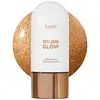What's inside
What's inside
 Key Ingredients
Key Ingredients

 Benefits
Benefits

 Concerns
Concerns

 Ingredients Side-by-side
Ingredients Side-by-side

Water
Skin ConditioningHydrogenated Polyisobutene
EmollientGlycerin
HumectantGlyceryl Oleate Citrate
EmulsifyingPentylene Glycol
Skin ConditioningSqualane
EmollientMica
Cosmetic ColorantHydroxyethyl Acrylate/Sodium Acryloyldimethyl Taurate Copolymer
Emulsion StabilisingKaolin
AbrasiveTocopherol
AntioxidantOryza Sativa Bran Extract
Skin ConditioningCitrullus Lanatus Fruit Extract
Skin ConditioningLens Esculenta Fruit Extract
Skin ConditioningHelianthus Annuus Extract
EmollientRosmarinus Officinalis Leaf Extract
AntimicrobialPyrus Malus Fruit Extract
Skin ConditioningSodium Hyaluronate
HumectantCaprylic/Capric Triglyceride
MaskingPhenoxyethanol
PreservativeBoron Nitride
AbsorbentSodium Stearoyl Glutamate
CleansingCaprylyl Glycol
EmollientSodium Benzoate
MaskingEthylhexylglycerin
Skin ConditioningHexylene Glycol
EmulsifyingXanthan Gum
EmulsifyingCitric Acid
BufferingPolysorbate 60
EmulsifyingSorbitan Isostearate
EmulsifyingSodium C14-16 Olefin Sulfonate
CleansingSodium Lactate
BufferingSodium PCA
Humectant1,2-Hexanediol
Skin ConditioningPotassium Sorbate
PreservativeBenzyl Alcohol
PerfumingTin Oxide
AbrasiveInula Helenium Extract
MaskingBenzoic Acid
MaskingCI 77491
Cosmetic ColorantCI 77492
Cosmetic ColorantCI 77499
Cosmetic ColorantCI 77891
Cosmetic ColorantWater, Hydrogenated Polyisobutene, Glycerin, Glyceryl Oleate Citrate, Pentylene Glycol, Squalane, Mica, Hydroxyethyl Acrylate/Sodium Acryloyldimethyl Taurate Copolymer, Kaolin, Tocopherol, Oryza Sativa Bran Extract, Citrullus Lanatus Fruit Extract, Lens Esculenta Fruit Extract, Helianthus Annuus Extract, Rosmarinus Officinalis Leaf Extract, Pyrus Malus Fruit Extract, Sodium Hyaluronate, Caprylic/Capric Triglyceride, Phenoxyethanol, Boron Nitride, Sodium Stearoyl Glutamate, Caprylyl Glycol, Sodium Benzoate, Ethylhexylglycerin, Hexylene Glycol, Xanthan Gum, Citric Acid, Polysorbate 60, Sorbitan Isostearate, Sodium C14-16 Olefin Sulfonate, Sodium Lactate, Sodium PCA, 1,2-Hexanediol, Potassium Sorbate, Benzyl Alcohol, Tin Oxide, Inula Helenium Extract, Benzoic Acid, CI 77491, CI 77492, CI 77499, CI 77891
Water
Skin ConditioningDimethicone
EmollientCyclopentasiloxane
EmollientButylene Glycol
HumectantCyclohexasiloxane
EmollientPolyacrylamide
Polysorbate 60
EmulsifyingEthylhexyl Methoxycinnamate
UV AbsorberC13-14 Isoparaffin
EmollientC9-11 Pareth-6
EmulsifyingTocopheryl Acetate
AntioxidantEthylhexyl Palmitate
EmollientEthylhexylglycerin
Skin ConditioningDisodium EDTA
Benzophenone-3
UV AbsorberBHT
AntioxidantPhenoxyethanol
PreservativeMica
Cosmetic ColorantCI 77891
Cosmetic ColorantIron Oxides
Water, Dimethicone, Cyclopentasiloxane, Butylene Glycol, Cyclohexasiloxane, Polyacrylamide, Polysorbate 60, Ethylhexyl Methoxycinnamate, C13-14 Isoparaffin, C9-11 Pareth-6, Tocopheryl Acetate, Ethylhexyl Palmitate, Ethylhexylglycerin, Disodium EDTA, Benzophenone-3, BHT, Phenoxyethanol, Mica, CI 77891, Iron Oxides
 Reviews
Reviews

Ingredients Explained
These ingredients are found in both products.
Ingredients higher up in an ingredient list are typically present in a larger amount.
Ci 77891 is a white pigment from Titanium dioxide. It is naturally found in minerals such as rutile and ilmenite.
It's main function is to add a white color to cosmetics. It can also be mixed with other colors to create different shades.
Ci 77891 is commonly found in sunscreens due to its ability to block UV rays.
Learn more about CI 77891Ethylhexylglycerin (we can't pronounce this either) is commonly used as a preservative and skin softener. It is derived from glyceryl.
You might see Ethylhexylglycerin often paired with other preservatives such as phenoxyethanol. Ethylhexylglycerin has been found to increase the effectiveness of these other preservatives.
Mica is a naturally occurring mineral used to add shimmer and color in cosmetics. It can also help improve the texture of a product or give it an opaque, white/silver color.
Serecite is the name for very fine but ragged grains of mica.
This ingredient is often coated with metal oxides like titanium dioxide. Trace amounts of heavy metals may be found in mica, but these metals are not harmful in our personal products.
Mica has been used since prehistoric times throughout the world. Ancient Egyptian, Indian, Greek, Roman, Aztec, and Chinese civilizations have used mica.
Learn more about MicaPhenoxyethanol is a preservative that has germicide, antimicrobial, and aromatic properties. Studies show that phenoxyethanol can prevent microbial growth. By itself, it has a scent that is similar to that of a rose.
It's often used in formulations along with Caprylyl Glycol to preserve the shelf life of products.
Polysorbate 60 is used to help stabilize products. It is a surfactant and emulsifier. These properties help keep ingredients together in a product. Surfactants help reduce surface tension between ingredients with different states, such as liquids and solids. Emulsifiers help prevent oils and waters from separating.
Polysorbate 60 is sorbitol-based and created from the ethoxylation of sorbitan. Ethoxylation is a chemical reaction used to add ethylene oxide. Sorbitan is a the dehydrated version of sorbitol, a sugar found in fruits.
In this case, the 60 comes from reacting 60 units of ethylene oxide with sorbitan.
Polysorbates are commonly used in medicine and foods.
Learn more about Polysorbate 60Water. It's the most common cosmetic ingredient of all. You'll usually see it at the top of ingredient lists, meaning that it makes up the largest part of the product.
So why is it so popular? Water most often acts as a solvent - this means that it helps dissolve other ingredients into the formulation.
You'll also recognize water as that liquid we all need to stay alive. If you see this, drink a glass of water. Stay hydrated!
Learn more about Water